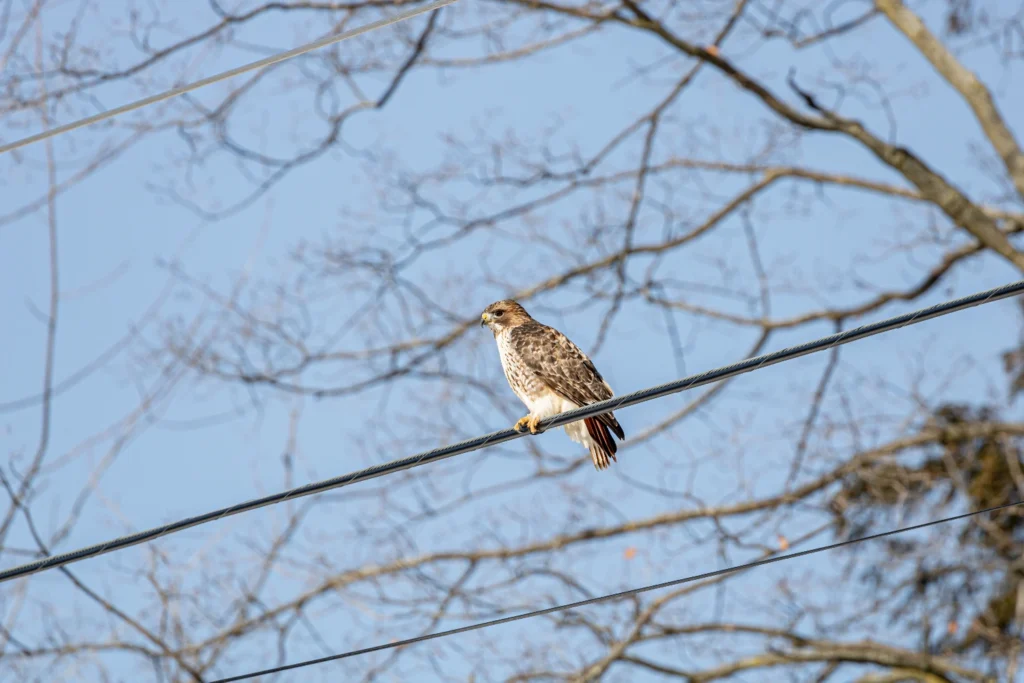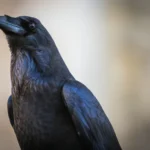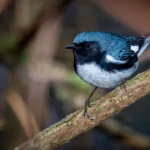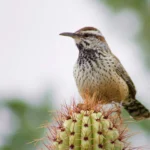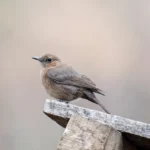Michigan’s diverse habitats, ranging from dense forests to open grasslands, provide a sanctuary for a wide variety of hawks. These birds of prey play a vital role in maintaining ecological balance, captivating birdwatchers and nature enthusiasts alike. From the agile Sharp-shinned Hawk to the rare Ferruginous Hawk, Michigan offers unique opportunities to observe these raptors in action. Whether soaring in migration or nesting in the state’s rich landscapes, each hawk species brings its own beauty and ecological importance, making Michigan a prime location for studying and admiring these incredible birds.
Types of Hawks in Michigan
Types of Hawks in Michigan
1. Sharp-shinned Hawk (Accipiter striatus)
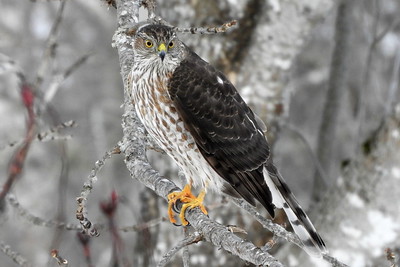
The Sharp-shinned Hawk is one of Michigan’s smallest hawks, known for its agile flight and swift hunting skills.
This raptor primarily preys on small birds, making it a common sight near bird feeders. It has a distinct appearance with a bluish-gray back, reddish-orange barred chest, and long tail with squared-off edges.
Sharp-shinned Hawks prefer dense forests but are also spotted in suburban areas during migration. These hawks are masters of ambush hunting, relying on speed and surprise to capture their prey. While they’re more visible during their migration in spring and fall, some stay year-round in Michigan’s forests, adapting well to the state’s varied climates.
Also Read : Hawks in Florida: Habitats, Diet, and Appearance of Majestic Raptors
2. Golden Eagle
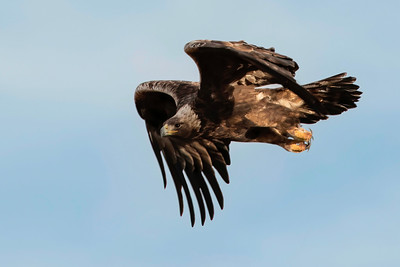
Though rare in Michigan, the Golden Eagle is a majestic sight, especially during migration seasons. Known for its striking golden-brown plumage and enormous wingspan, this eagle exudes power and grace.
Golden Eagles typically inhabit open terrains, such as grasslands and mountainous areas, but they are spotted in Michigan’s skies during their migration to southern territories.
Their diet mainly consists of small to medium mammals, including rabbits and squirrels. These raptors are exceptional hunters, capable of soaring for hours while scanning for prey.
Conservation efforts have helped stabilize their population, making them an occasional, awe-inspiring visitor to the state’s wild landscapes.

3. Short-tailed Hawk

The Short-tailed Hawk is a rare visitor to Michigan, mainly sighted during migration. This medium-sized raptor is distinguished by its contrasting plumage—dark brown above and white below.
It’s a highly adaptable species, often found in both forested and open areas. Known for its soaring abilities, the Short-tailed Hawk hunts by gliding high above and swooping down on unsuspecting prey.
Their diet consists of small birds, reptiles, and insects. While they are more common in Florida and Central America, occasional sightings in Michigan’s southern regions add excitement for birdwatchers seeking diversity in raptor species.
Also Read : Discover 10 Types of Hawks in Illinois
4. Zone-tailed Hawk

The Zone-tailed Hawk, often mistaken for a Turkey Vulture due to its similar appearance, is an uncommon sight in Michigan. Its dark plumage and distinctive white bands on the tail set it apart.
This raptor mimics vultures’ flight patterns to sneak up on prey, a unique hunting strategy among hawks. Zone-tailed Hawks are primarily found in the southwestern U.S., but rare wanderers have been reported in Michigan. They feed on small mammals, birds, and reptiles.
Their occasional presence in Michigan adds to the state’s impressive list of hawk species, making them a sought-after species for avid birdwatchers.
5. Harris’s Hawk
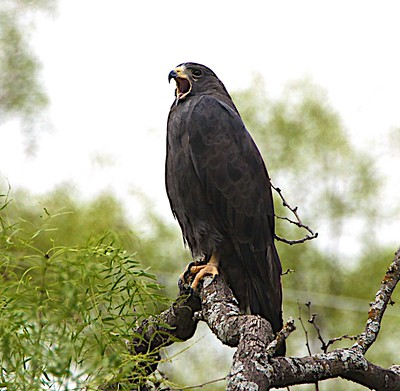
Harris’s Hawk is a strikingly social bird, often hunting in groups, a behavior rare among raptors.
With its dark brown plumage, chestnut-colored shoulders, and white-tipped tail, it’s easily recognizable. While native to the southwestern U.S. and Central America, Harris’s Hawks are rare visitors to Michigan. They thrive in open desert-like habitats but adapt well to various environments.
Their cooperative hunting style allows them to tackle larger prey, including jackrabbits and other mammals. Though uncommon in Michigan, occasional sightings inspire bird enthusiasts to keep an eye out for these unique hawks.
6. Northern Harrier (Circus hudsonius)
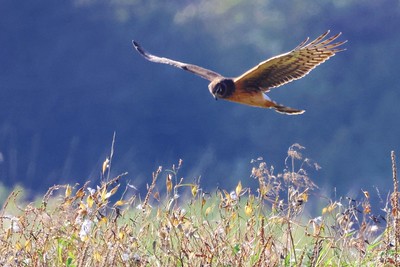
The Northern Harrier is a graceful hawk often seen gliding low over Michigan’s marshes and grasslands. Recognized by its owl-like facial disk and long wings, this raptor relies on keen hearing and vision to locate prey.
The males display gray plumage with white undersides, while females are larger and sport brown tones. Northern Harriers feed on small mammals, birds, and reptiles, adapting their diet based on availability.
These hawks are year-round residents in Michigan, though their numbers peak during migration seasons. Their distinctive hunting style and elegant flight make them a favorite among birdwatchers and wildlife enthusiasts.
Also read: Commonly Found Small Brown Birds in Florida
7. Broad-winged Hawk (Buteo platypterus)
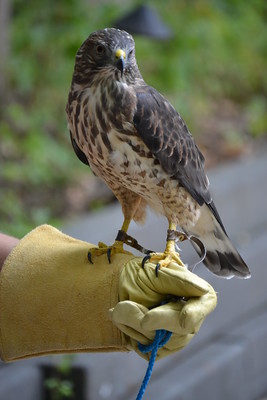
Broad-winged Hawks are small, stocky raptors best known for their spectacular migratory behavior. Every fall, thousands of these hawks form kettles, soaring together in swirling groups during their journey south.
In Michigan, they are summer residents, nesting in dense forests. Their plumage is brown above and white with horizontal barring below, providing excellent camouflage.
Broad-winged Hawks primarily hunt small mammals, amphibians, and insects, often swooping down from a perch. They are vocal during the breeding season, emitting high-pitched whistles to communicate. Observing their migration is a highlight for birders, as these hawks represent one of nature’s incredible spectacles.
8. Red-shouldered Hawk (Buteo lineatus)
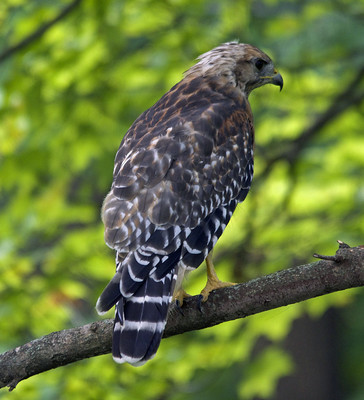
The Red-shouldered Hawk is a medium-sized raptor often found in Michigan’s wooded wetlands. It’s named for the reddish-brown patch on its shoulders, complemented by a checkered pattern on its wings and a banded tail.
These hawks are vocal, with a distinctive kee-aah call that echoes through the forests. Their diet includes small mammals, amphibians, and reptiles, with occasional forays into aquatic prey.
Red-shouldered Hawks are year-round residents in southern Michigan, but their numbers increase during migration. Their preference for mature forests and swamps makes them an important indicator of the health of these ecosystems.
9. Rough-legged Hawk (Buteo lagopus)
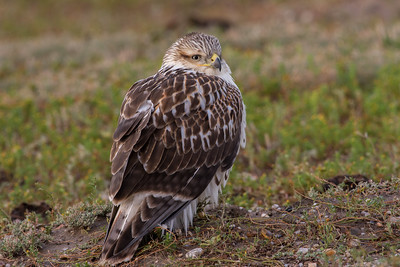
Rough-legged Hawks are winter visitors to Michigan, migrating from their Arctic breeding grounds.
They are easily identifiable by their feathered legs, a unique adaptation to cold climates. These hawks have variable plumage, typically featuring a dark belly band and light underparts.
Open fields and grasslands are their preferred habitats, where they hover in search of small mammals, especially voles. Their hovering hunting style and ability to adapt to harsh winter conditions make them a fascinating species to observe.
Birdwatchers often spot them perched on utility poles or fence posts during Michigan’s colder months.
10. Swainson’s Hawk (Buteo swainsoni)

Swainson’s Hawk is a long-distance migrant occasionally seen in Michigan during its migration.
This slender raptor has a striking appearance with brown upperparts and a contrasting white throat and chest. They are highly sociable, often forming large flocks during migration.
Their diet shifts seasonally, feeding on insects like grasshoppers during summer and small mammals in other seasons. Swainson’s Hawks prefer open areas like prairies and fields, but sightings in Michigan add excitement for birders.
Their incredible migration to South America highlights their adaptability and resilience, making them one of the most remarkable hawks to observe.
11. Ferruginous Hawk (Buteo regalis)
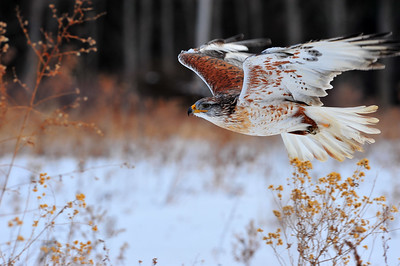
The Ferruginous Hawk, the largest of the Buteo species, is a rare visitor to Michigan. It’s named for its rusty-colored plumage and has strikingly large wings.
Native to the open plains of the western U.S., this hawk occasionally ventures eastward, offering rare sightings in Michigan. Its diet primarily consists of small mammals, including prairie dogs and ground squirrels.
Ferruginous Hawks are known for their powerful build and majestic flight. Though rare, their presence in Michigan’s open areas captivates birdwatchers. Conservation efforts focus on protecting their habitats to ensure these impressive raptors continue to thrive.
12. Northern Goshawk
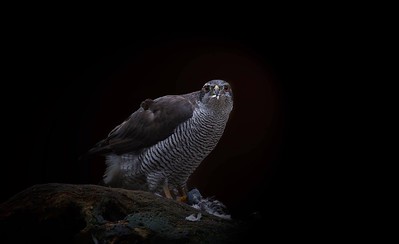
The Northern Goshawk is a formidable predator and one of Michigan’s most elusive hawks. This large raptor has slate-gray plumage, a white eyebrow stripe, and piercing red eyes.
Known for their fierce hunting style, Northern Goshawks primarily prey on birds and mammals, including squirrels and rabbits. They inhabit dense forests, making them challenging to spot.
These hawks are year-round residents in Michigan but are more active during the breeding season. Their aggressive territorial behavior and swift flight make them a symbol of wilderness and power. Bird enthusiasts treasure glimpses of these secretive raptors in Michigan’s woodlands.
Conclusion
Michigan’s hawks, with their remarkable hunting skills and diverse adaptations, enrich the state’s wildlife tapestry. From common year-round residents like the Red-shouldered Hawk to rare visitors like the Zone-tailed Hawk, each species highlights the beauty and complexity of the natural world.
Observing these raptors not only fosters appreciation for Michigan’s biodiversity but also emphasizes the importance of conservation efforts. Whether you’re an avid birdwatcher or a casual nature lover, encountering hawks in Michigan’s skies is a thrilling reminder of the wonders of the wild.

Welcome to World Birds Life, where the wonder of birds takes center stage. My name is Lexi, and I’m passionate about helping you discover the beauty and joy that birds bring into our lives.

